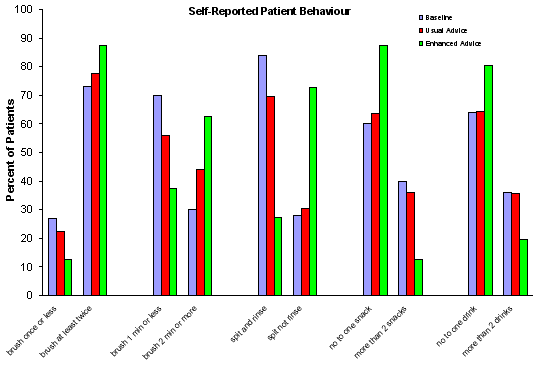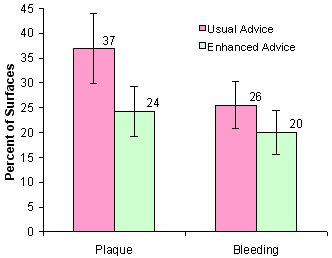Ths peer reviewed article was first published in the journal Tuith OnlineA Randomised Controlled Trial To Investigate The Effects Of Enhanced Oral Health Advice Upon Self-Reported Patient Behaviour, Oral Cleanliness, And Gingival Health (ISRCTN55563468)Objectives
Summary of Study28 vocational trainees in Aberdeen, Dundee, and Perth and 219 of their patients participated in the study. Patients were randomly allocated to receive either the usual advice or enhanced advice with oral health literature. Of the 122 patients who returned for a second visit to their dentist's surgeries, 49% were in the usual advice and 51% were in the enhanced advice group. The interval between first and second visit varied between one week and eleven weeks with a mean of 3.1 weeks. Selected ConclusionsChanges in Behaviour Self-reported patient behaviour was assessed by means of patient questionnaires completed before advice was given and at a return visit. The enhanced advice, including the issue of a "Key Message" card and Colgate's "Plaque and Periodontal Disease" leaflet, was designed to encourage not only effective tooth-brushing technique at least twice per day, but also changes in dietary habits. There was no difference between the reported behaviour of the two groups at the baseline assessment. Post intervention, patients in both groups reported an increase in tooth-brushing time, a move to not spitting out after brushing, and a reduction in the consumption of snacks and sugary drinks (figure 1). Figure 1. 
Reported behaviour was statistically significant between the groups with a higher proportion of those patients who received the enhanced advice now reporting brushing for 2 minutes or more, eating one snack or less per day, and spitting without rinsing following tooth brushing (table 1 ). Table 1. Post-intervention patient reported behaviour.
Pearson Chi-Squared comparison between usual advice and enhanced advice groups for the variables illustrated in figure 1. Significant differences are shown in bold. Changes in Plaque and Gingival BleedingThe patients' oral cleanliness status was assessed by recording the presence or absence of plaque on the buccal and lingual surfaces of all teeth in the upper right and lower left quadrants. Gingival health status was assessed by the presence or absence of bleeding on gentle probing of the margin at these sites. Figure 2 shows that the mean percentage of surfaces with plaque and gingival bleeding was less in the enhanced advice group at the return visit. However, only the difference in plaque was statistically significant (P < 0.005). As expected, there was a statistically significant positive correlation between patients' plaque and bleeding scores (P < 0.001). The statistically significant negative correlation between the number of teeth present and plaque (P < 0.001), that is to say patients with fewer teeth tended to have higher plaque scores, was consistent with a similar finding reported in the 1998 UK Adult Dental Health Survey (Office for National Statistics). There was no statistically significant association between the number of teeth and gingival bleeding scores. Figure 2. Mean percentages of surfaces with plaque or gingival bleeding per individual. 
Training experience of traineesA post study questionnaire indicated that vocational trainees believed that enhanced oral advice was likely to change patients behaviour for the better. There was a mix of opinions between those who thought that recruiting patients to studies and adhering to an experimental protocol was easy and those who felt it was just too difficult. In particular there was difficulty in identifying patients who had not received oral health advice recently (on previous visits out with the study) whereas newly registered patients could not always be seen again within the study period. When considering the feasibility of conducting clinical trials in general practice, some trainees felt that normal clinical routine could be maintained; others disagreed. Only one trainee felt that it was not possible to successfully carry out clinical trials in general dental practice. The views expressed in the post-study questionnaires in conjunction with those expressed by a post-study focus group have highlighted the need for greater vocational trainee and trainer involvement at all stages of a clinical trial. In future the input of trainees and trainers will be sought at all stages of the trial process. ImplicationsThis trial has demonstrated that advice enhanced with oral health promotion literature can lead to an improvement in self-reported oral health behaviour and oral cleanliness People involvedThe encouragement and enthusiastic co-operation of Wendy McCombes, Stephen Rafferty, Colin Yule, Derek Harper, and trainers and trainees in the initiation and execution of this study is gratefully acknowledged. Supported by the Scottish Dental Practice Based Research Network (SDPBRN) Linda Young1, Brian C. Bonner1, Patsy Smith1, and Jan E. Clarkson1,2
|
||||||||||||||||||||||||||||||
|
Web space provided by the University of Dundee,
maintained by
the Dental Health Services Research Unit. Valid XHTML1.0
| ||||||||||||||||||||||||||||||
 |
Evidence-based dentistry web-site | |